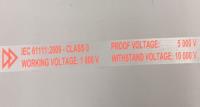 Add My Company
Add My Company
Sign In

Electrical insulation aims to prevent the formation of electrical flow between different parts of electrical equipment. Whether you are considering using solar panels, heat pumps, or any other electrical machinery, using an electrical insulator is best to improve safety and security in a residential or industrial environment. Insulators ensure maximum resource use and reduce energy waste. You can end up spending a lot of money to cover your energy needs by skipping this simple and effective step. Electrical Insulation Carpets, rubber matting, glass, and plastic sheeting, etc. are some common examples of electrical insulating materials.
Reason to Use Electrical Insulation
Electrical insulators, also called non-conductors, are materials that do not allow electrical current to pass through them; they have no moving electrical charges themselves. These electrical insulating units operate by binding electrons to prevent the electric flow between them; this results in the absence of conductivity. Insulators are used for printed circuit boards, high voltage wires, and coatings for open wires or cables. Common examples of electrical insulators are rubber matting, glass, plastic, electrical insulating carpets made of wool, and other solid ionic substances.
Types of Insulators for Electrical Circuitry
Pin Insulators
Pin electrical insulators are the most typical and commonly used electrical insulators for overhead power lines or industrial circuitry. Active electrical conductors are placed either on or under the insulation unit, and the insulator has to carry the voltage tension between the earth andthe conductor. As these insulators are installed in an open environment, they have sheds to protect them against rain.Ground lines connected with high tension circuitry can be operated with secondary materials such as insulating electrical carpets or rubber matting to provide safety for ground workers.
Post Insulators
Post support insulator units have the same shape as pin insulators but have a more exceptional ability to withstand high voltages. These units can be mounted vertically or horizontally on a supporting structure. Such units are made of porcelain, with adjusting clips at the bottom and top for affixing to the supporting structure. A distinguishing factor of support insulators is that multiple insulators can be connected together to be of more use.
Strain Insulator
Strain or rope insulators are used when the connection lines have dead-end corners present. The insulation should have high mechanical strength to withstand the high electric charges and tensions. Typically, electricians use electrical rubber matting or electrical insulating carpets when working under this type of corner conductor and its ground circuitry for an extra level of safety.
Shackle and Stay Insulators
These are generally low voltage electrical distribution insulators and related networks typically found in domestic usage. Insulator supports are made of the porcelain material used to hold wires and are designed in such a way that the cable does not fall to the ground if the insulation is damaged. Shackle insulators work the same way, except that they have an insulator groove attached with a connection cable. They are usually used in a row near the ground, so workers generally use electrical insulation carpets or rubber matting as an additional safety measure. For more information contact Matsdirect UK Limited.
For more information on What are the types of electrical insulators and how to stay safe around them! talk to MatsDirect UK Ltd
Enquire Now
More Blogs
List your company on FindTheNeedle.

